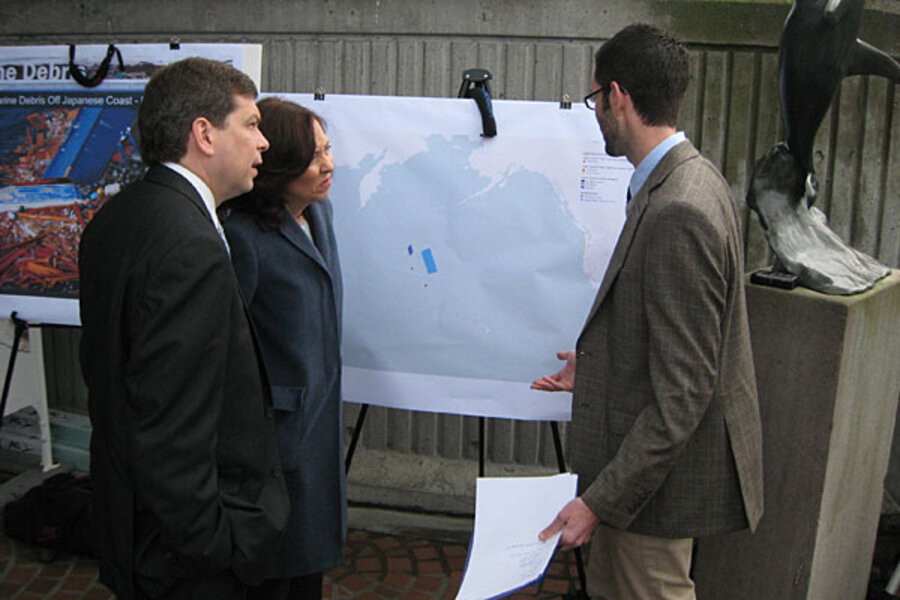Japanese tsunami debris to hit West Coast this year, sooner than expected
Loading...
The earliest debris from last March's Japanese tsunami has already made landfall in the Western United States, and the larger debris field is now expected to come ashore this year, according to new estimates by the National Oceanic and Atmospheric Administration.
An earlier model had suggested that the bulk of the debris, which is now dispersed north of the Hawaiian islands, would wash up on the West Coast next year. But now government agencies and local volunteer groups are moving their preparations forward.
The event will likely be spread over most of the next year, with items easily blown by ocean winds arriving first, NOAA says. As the center of the densest patches moves in, the amount of debris should increase substantially. The denser patches of debris are unlikely to be a mass, but rather a more coherent collection over fewer square miles.
The question of who will be responsible for cleaning beaches in Alaska, Washington, Oregon, and northern California remains. Various federal, state, and local groups appear to be planning something, though not necessarily the same thing or at the same time. Although they are working together, there is no single plan being created, nor is there one agency with whom the tsunami buck stops.
If everything goes ideally, that may not be an issue. But if a situation arises in which either confusion or reluctance reigns, the absence of a “law of the land” guiding document and a single responsible party could result in confusion.
The likely first debris from the tsunami struck the West Coast in December of last year at Neah Bay, the northwest point of Washington’s Olympic Peninsula. It was a large black Japanese float the size of an oil drum. More dramatically, a derelict Japanese fishing boat called the Ryou-Un Maru drifted into the Gulf of Alaska in March where, after it was declared unsalvageable, was used as target practice by the US Coast Guard
Japan’s Ministry of the Environment has estimated that 5 million tons of debris washed into the Pacific during the 9.0-magnitude Tohoku earthquake and tsunami, 70 percent of which quickly sunk in Japanese waters. That leaves as much as 3 billion pounds of garbage to wash up on the western coasts of North America.
The debris is unlikely to be different from the debris that washes up all the time – wood, plastic, building materials, floats, and so on, much of it traveling on the currents from Japan.
Moreover, it is unlikely to be radioactive. Though the earthquake damaged Japan’s Fukushima Daiichi nuclear power plant, resulting in meltdowns in the core and the release of radioactive materials, the Fukushima area represented only a miniscule part of the total area affected by the tsunami.
In addition, most of the debris from the tsunami had already been washed out to sea before the Fukushima crisis. And even if any debris had been radioactive, it would by now have been diluted to the point of ineffectuality, say officials.
“This is not going to be a radiation event,” said Rick Wendt, head of radiation protection for the Oregon Health Authority.
Some groups are already out on Western beaches. Oregon’s SOLVE, involved since 1969 in extensive volunteer beach-cleaning efforts, has been working with NOAA to record debris as it washes up.
Other organizations are preparing, too. Oregon State Parks are consulting with the state’s emergency-management division to create a plan for reacting to and disposing of the debris. This plan, according to Oregon State Parks’ Jim Morton, is a month to six weeks away.
NOAA, state park authorities, the Coast Guard, state emergency-management officials, the Environmental Protection Agency, and volunteer groups are all in regular contact, but there is no overarching plan, clear hierarchy, or responsible party for the debris issue as a whole.
NOAA is the default coordinator, according to Nir Barnea, West Coast coordinator for NOAA’s Marine Debris program. The EPA, state department of environmental quality, and Coast Guard share responsibility for any hazardous material. Each state’s park authority is responsible for disposing of non-hazardous materials.
Officials say that anyone who spots what seems to be hazardous debris or unknown objects should not touch them, but rather get the attention of local authorities and let them handle the identification and disposal.
For example, a beachcomber who finds tsunami debris could take a photo with a smartphone and e-mail it to disasterdebris@noaa.gov, as well as report the find to the nearest authority. In the unlikely event of that human remains – or any material “of sentimental value,” such as jewelry – are found, the Japanese consulate would be brought in.
The efforts could have budget consequences. “Cleanup is where the rubber meets the road,” Mr. Morton of Oregon State Parks says. “We have a budget for the entire coastline and that could be exceeded. If that happens, we will have to go to the Office of Emergency Management to help offset that cost.”







